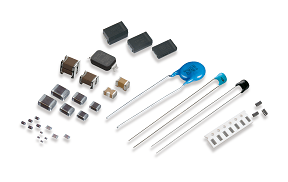Capacitor

Capacitor Guide
"There might be new applications for even smaller capacitors. Look into it, will you?" The General Manager of the Development Department said to me shortly after being assigned to the development of multilayer ceramic capacitors. This was at a time when 1.0×0.5×0.5mm capacitors were finally launched. As for me, I had just been reassigned from the fly-back transformer section to the capacitor section, and was still an absolute beginner in regard to capacitors. I was much like a new employee fresh out of practical training in the manufacture of capacitors, although at the time, in 1994, I was actually in my tenth year at Murata.
I really had no idea what to do, so I decided to draw up a development plan. I first consulted with the product technology manager, production technology manager, and planning manager, and received various insights from them.
Then, I studied past changes in the sizes of multilayer ceramic capacitors and their mounting density on substrates, and plotted the results on a graph. Based on this task, I concluded that there would be a need for 0.6×0.3×0.3mm capacitors in 1999. I drew up a development plan and presented it to (be more specific. Instead of people, say "our department members" or "the management team")
Their reaction was disappointing. The majority of opinions were negative or skeptical, questioning the feasibility of mounting such a small component and its acceptability in the market. It was then that the product technology manager advised me of the tactic of providing three options in a final desperate attempt to promote my idea. What the tactic essentially constituted was this: just as people who are given three different ranks of unadon (unagi rice bowls) would mostly choose the middle rank, we could produce 0.6×0.3×0.3mm capacitors to sell the 1.0×0.5×0.5mm line of capacitors. Needless to say, this was nothing more than sophistry; we actually believed that our 0.6×0.3×0.3mm capacitors would sell.
With the motive for development such as it was, I had only one assistant to help me develop the 0.6×0.3×0.3mm capacitor. Nonetheless, we began test production using the 1.0×0.5×0.5mm capacitor line. Our first attempt was utterly flawed, with a 99% defective rate, but there were nonetheless some samples that displayed the desired characteristics. We were convinced that we could do it. I kept the sample we had produced and securely packaged it for safekeeping until the 0.4×0.2×0.2mm capacitor was developed much later.
From this point on, everything was an uphill battle. The components were smaller than the lead of a mechanical pencil, yet we enclosed each one in resin, then polished and individually checked them for fault modes. It was a daunting task. However, there was a funny episode when I was performing this task one day and accidentally flipped a defective yet precious chip into the air while I was trying to pick it up with tweezers. I could not find it no matter how much I searched, so I eventually gave up and went home. But back home, when I just happened to scratch my head while reading a book, a tiny object fell out of my hair. It was the defective chip I had looked everywhere for! I burst out laughing!.
After sorting the defective modes, formulating countermeasures, and evaluating the first samples, we commenced our second test production. This time, we succeeded in producing 50% acceptable products. We had spent a little more than six months up to this point, proceeding headlong into producing the 0.6×0.3×0.3mm capacitor, but at this point we strengthened our capacity by welcoming S, a new employee, to our team. I should note that S thereafter became the central leader in the development of the 0.4×0.2×0.2mm capacitor.
Now we needed to improve the non-defective rate while at the same time exploring characterization methods, mounting methods, and other such matters that pertain to providing usability to customers, so we commenced joint development with our production technology department, as well as with an outside measuring instrument manufacturer, taping machine manufacturer, and mounting machine manufacturer. As these joint development activities required tens of thousands of samples for facility development and mounting evaluation, we went to a lot of trouble to secure the necessary amount of samples. We paid our respects to the supervisor of manufacturing and arranged to have our samples produced, by convincing him of the necessity and future promise of our 0.6×0.3×0.3mm capacitor. The manufacturing sections were in their busy period, but went out of their way to secure some time for us. We are ever grateful for their cooperation.
~To be continued (2011 July 28th.)~
Written by: T.N., Murata Fukui Manufacturing Co., Ltd.
The information presented in this article was current as of the date of publication. Please note that it may differ from the latest information.